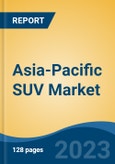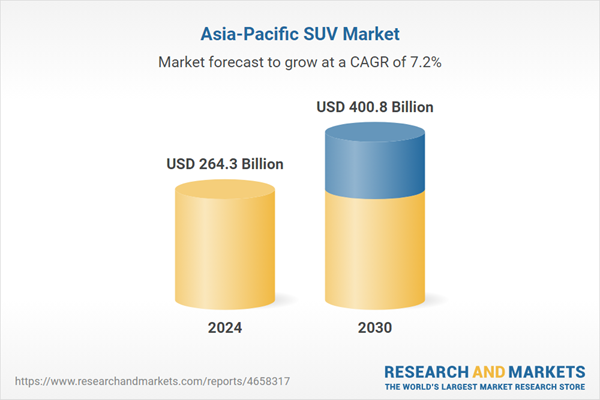Speak directly to the analyst to clarify any post sales queries you may have.
10% Free customizationThis report comes with 10% free customization, enabling you to add data that meets your specific business needs.
This demand is further amplified by favorable lending rates and flexible financing options, enabling middle-income groups to purchase vehicles in this segment. Innovation in powertrain technology and a rising focus on sustainability are transforming the competitive landscape. Hybrid and electric SUVs are gaining traction due to supportive government regulations promoting cleaner mobility solutions. The development of charging infrastructure and subsidies on hybrid or electric vehicles are encouraging buyers to consider fuel-efficient alternatives. Furthermore, automakers are investing in R&D to integrate features such as semi-autonomous driving, ADAS, and intelligent infotainment systems, aligning with tech-savvy consumer expectations and regulatory standards.
Market Drivers
Surge in Middle-Class Population
A significant factor propelling SUV adoption in Asia-Pacific is the expansion of the middle-class demographic. With rising income levels, families are shifting from compact sedans or hatchbacks to more spacious SUVs. These vehicles offer practicality, better visibility, and a sense of safety, making them highly appealing. In nations like India and Indonesia, the SUV becomes a symbol of economic ascent and lifestyle improvement, resulting in increased sales across urban and semi-urban areas. Automakers are capitalizing on this shift by introducing multiple variants within entry-level SUV segments.Key Market Challenges
Shift Towards Electric SUVs
The transition to electric mobility is gaining momentum across the Asia-Pacific region. Governments are setting aggressive targets for EV adoption, while OEMs are launching new battery-powered SUV models. Consumers are responding positively to offerings with longer driving ranges, lower running costs, and improved performance. This trend is supported by collaborations between automakers and energy firms for better infrastructure. Huawei Technologies unveiled plans to install 100,000 fast electric vehicle charging stations across China within a year. This initiative aims to bolster the country's EV infrastructure, facilitating broader adoption of electric vehicles, including SUVs, and supporting China's environmental goals.Key Market Trends
Shift Towards Electric SUVs
The transition to electric mobility is gaining momentum across the Asia-Pacific region. Governments are setting aggressive targets for EV adoption, while OEMs are launching new battery-powered SUV models. Consumers are responding positively to offerings with longer driving ranges, lower running costs, and improved performance. This trend is supported by collaborations between automakers and energy firms for better infrastructure. Huawei Technologies unveiled plans to install 100,000 fast electric vehicle charging stations across China within a year. This initiative aims to bolster the country's EV infrastructure, facilitating broader adoption of electric vehicles, including SUVs, and supporting China's environmental goals.Key Market Players
- Ford Motor Company
- General Motors
- AUDI AG
- Kia Motors Corporation
- Groupe Renault
- Groupe PSA
- SAIC Motor Corporation Limited
- Daimler AG
- BMW AG
- Mahindra & Mahindra Limited
Report Scope:
In this report, the Asia-Pacific SUV Market has been segmented into the following categories, in addition to the industry trends which have also been detailed below:Asia-Pacific SUV Market, By Transmission Type:
- Automatic
- Manual
Asia-Pacific SUV Market, By Fuel Type:
- Diesel
- Petrol
- Hybrid
- Others
Asia-Pacific SUV Market, By Seating Capacity:
- 5-Seater
- >5-seater
Asia-Pacific SUV Market, By Country:
- China
- India
- Japan
- South Korea
Competitive Landscape
Company Profiles: Detailed analysis of the major companies present in the Asia-Pacific SUV Market.Available Customizations:
With the given market data, the publisher offers customizations according to the company’s specific needs. The following customization options are available for the report.Company Information
- Detailed analysis and profiling of additional market players (up to five).
This product will be delivered within 1-3 business days.
Table of Contents
Companies Mentioned
- Ford Motor Company
- General Motors
- AUDI AG
- Kia Motors Corporation
- Groupe Renault
- Groupe PSA
- SAIC Motor Corporation Limited
- Daimler AG
- BMW AG
- Mahindra & Mahindra Limited
Table Information
| Report Attribute | Details |
|---|---|
| No. of Pages | 140 |
| Published | July 2025 |
| Forecast Period | 2024 - 2030 |
| Estimated Market Value ( USD | $ 264.3 Billion |
| Forecasted Market Value ( USD | $ 400.8 Billion |
| Compound Annual Growth Rate | 7.1% |
| Regions Covered | Asia Pacific |
| No. of Companies Mentioned | 10 |









